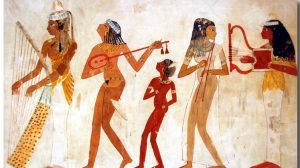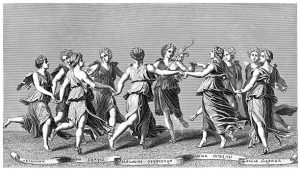Happy World Dance Day! For today’s honor, we explore the enchanting intersection of dance and magic, a connection steeped in history and spiritual traditions across the globe.
Dance, much like magic, has been an integral part of human culture and spirituality for millennia. It is a universal language that transcends boundaries, a sacred expression that allows us to communicate with the divine, nature, and our inner selves.
The Dance of the Divine: Ancient Rituals
In ancient cultures, dance was often a key part of spiritual and magical practices. These dances were not merely performances, but sacred rituals, each movement filled with meaning and intention.
In Ancient Egypt, temple dances were performed by priestesses to honor the gods and goddesses. The rhythmic movements were believed to mirror the celestial dance of the stars and planets, creating a magical link between the heavens and the earth.

Similarly, in many Native American tribes, dances like the Rain Dance or the Sun Dance were performed to connect with nature’s spirits and to bring balance and harmony to their communities.
Ancient Dancers
In Ancient Greece, one of the most famous dancing rituals was the “Dance of the Labyrinth” performed by young men in Cretan society. This dance was associated with the myth of Theseus and the Minotaur, symbolizing the journey through the labyrinth.
Moreover, the ancient Greeks also had choruses, where dance was used as an integral part of theatrical plays and musical performances. During the Dionysian festivals, dedicated to Dionysus, the god of wine and ecstasy, participants performed frenzied, ecstatic dances, often losing themselves in the rhythm and movement as a form of liberation and connection to the divine. These dances were seen as sacred rituals, a divine embodiment of beauty, and a celebration of life’s rhythmic cycles.
Well, dance is still a huge thing in India. So it is not a surprise that in ancient India, dance was deeply intertwined with spirituality and religious rituals. One of the most revered dance forms is the “Bharatanatyam,” a classical Indian dance with origins traced back to the Hindu temples of Tamil Nadu. This dance was performed by the Devadasis, or temple dancers, as a form of worship and devotion to the gods.
Similarly, “Kathakali,” a traditional dance from Kerala, was used to narrate epic Hindu tales and mythologies, with each gesture and movement filled with profound meaning. These dances were not merely art forms, but sacred rituals designed to connect the human and the divine, to express religious devotion, and to create a spiritual experience that transcended the ordinary realm.
Dance as a Spell: The Power of Movement
Just as we cast spells with words and symbols, dance too can be a potent form of magic. And our ancient ancestors knew that. Each step, each twirl, and each leap can be imbued with intention, creating a powerful energetic resonance.
When we dance, we engage our entire being – body, mind, and spirit. This holistic involvement allows us to channel our energy more effectively, making our intentions clear and strong. As we move, we also stir the energy around us, creating a ripple effect that can manifest our desires into reality.
Dance and Energy: The Flow of Life Force
Dance, in its essence, is a dynamic expression of life force or prana. It is a way to channel and manipulate this energy, much like in magical practices. When we dance, especially in a ritualistic context, we raise our vibrational frequency and can direct this energy toward our magical intentions.

In many modern pagan and Wiccan practices, dance is often incorporated into rituals and celebrations. During the dance, practitioners visualize their intentions, using their movements to raise and direct energy.
Paulo Coelho explains this power of dance in his novel “The Witch of Portobello” perfectly. The protagonist, Athena, uses dance as a profound spiritual practice. For Athena, dance is not just an artistic expression, but a means of connecting with the divine and achieving a state of trance.
Through dance, she can release her inhibitions, explore her inner self, and access a level of consciousness beyond the ordinary. Dance becomes her ritual, her magic, and her pathway to the divine. This theme beautifully illustrates Coelho’s perspective on the spiritual potential of dance, as well as its transformative and transcendent power.
Dancing with the Elements: Connection to Nature
Dance allows us to connect with the elements of nature – earth, air, fire, and water. Each element corresponds to different types of movements: grounded and steady for the earth, swift and light for air, passionate and dynamic for fire, and flowing and graceful for water. By embodying these elements in our dance, we can deepen our connection to nature and its magical energies.
You can try Qigong. It is a centuries-old system of coordinated body posture and movement, breathing, and meditation used for health, spirituality, and martial arts training. Originating in China, it is part of traditional Chinese medicine (TCM) and is often described as “moving meditation.” Qigong incorporates the understanding and manipulation of the Five Elements (also known as the Five Phases) – Wood, Fire, Earth, Metal, and Water. Each element has its movement and by doing that you can work with your body’s elements. Also, it looks so cool like your dancing but also bending the elements like Avatar Aang!
So, on this World Dance Day, let’s honor the ancient tradition of dance and its magical roots. Let’s dance with intention, with joy, and with the knowledge that in every step we take, we are dancing with the divine.
Raference:
- Research Gate: “Association of Dance with Sacred Rituals in Ancient Greece: The Case of Eleusinian Mysteries”
- Bryn Mawr Classical Review: “Aspects of Roman Dance Culture“
- JSTOR: “Ancient and Modern Ritual Dances in the Near East”
- Paulo Coelho Blog: “When we dance, we are free”
